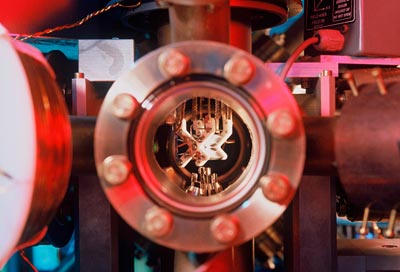
Physicists in Austria have demonstrated a “quantum walk” in detail for the first time, using trapped ions. Such experiments could allow us to better understand the transition between the quantum and classic worlds, and could be applied to a variety of research including quantum computing and the study of quantum effects in nature.
The random walk can be used to describe many systems from fluctuations in the stock market to the Brownian motion of pollen grains on the surface of a liquid. It is usually described by a lost hiker who chooses his itinerary according to the toss of a coin: if he gets heads, for example, he takes one step to the right and if tails, a step to the left. After many coin tosses, the hiker’s position is random, but likely to be close to the starting point.
Quantum random walks, first proposed by Nobel laureate Richard Feynman, are, however, very different. After every toss of the coin, a quantum particle moves in both directions at the same time and adopts a “coherent superposition” of right and left. This means that there are always several possible paths the quantum walker can take to arrive at its final position.
Paths interfere
According to the rules of quantum mechanics, these possible paths interfere. Thanks to this interference, the final probability distribution describing the likelihood of finding a particle at a given location is very different to that of its classical counterpart – the quantum particle tends to move away from its original position much faster than a classical particle.
Researchers, including Christian Roos from the Institute of Quantum Optics and Quantum Information at the Austrian Academy of Sciences, have succeeded in measuring this probability distribution and show that it indeed follows the quantum behaviour expected. They demonstrate a 23-step quantum walk – the longest to date – which involves two particles for the first time. The finding builds on recent research, including work published last July that involved a 10-step quantum walk involving a single ultracold atom.
In their experiments, Roos and his team begin with a single calcium ion in an ion trap and cool it so that it is in its lowest energy state – the ground state. The researchers initiate movement by firing laser pulses that transfer momentum to the ion and, depending on the internal state of the ion, it is pushed to the left or right.
However, before each step, the researchers prepare the ion in a quantum mechanical superposition of two internal states, by firing it with a separate laser. In this way, each time the ion is pushed, each part of its wavefunction has the same opportunity to move in either direction. “These two steps – the pushing and scrambling pulses – make up one elementary step of the quantum walk,” explains Roos.
Mapping the ion’s position
The scientists repeated this process 23 times and collected data about the motion by detecting the florescence emitted by the ion. Analysing the numerous steps in this way allowed them to build up a map of the probability distribution of the ion’s position. To extend their research the scientists use two ions, giving each walker the additional possibility to stay instead of taking a step. Importantly, with one and two walkers, the researchers confirmed that the quantum walk is very different to the classic random walk, because the quantum particles spread much faster on their walks.
“These new experiments describe nicely how the quantum walk can be extended to more steps than previously demonstrated, and on two walkers at a time” says Tobias Schaetz of the Max Planck Institute of Quantum Physics in Germany, whose group also studies quantum walks.
“The results could be applied to studying natural phenomena”, says Roos. “For example, researchers have long suspected that energy transport in plants is more efficient thanks to quantum walks.” Applying quantum walks to quantum computer models could also help develop highly advanced search algorithms that would outperform their classic counterparts, because different outcomes for a given calculation could be chosen at the same time.
The work is published in Physical Review Letters.


